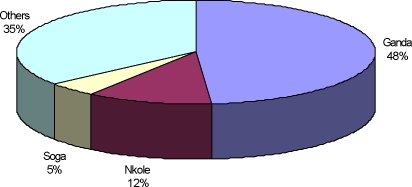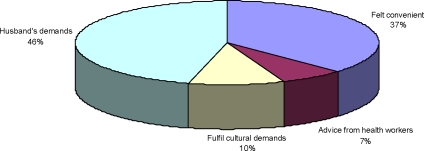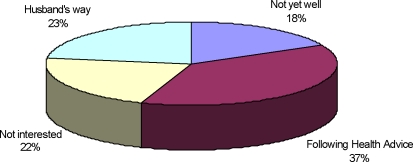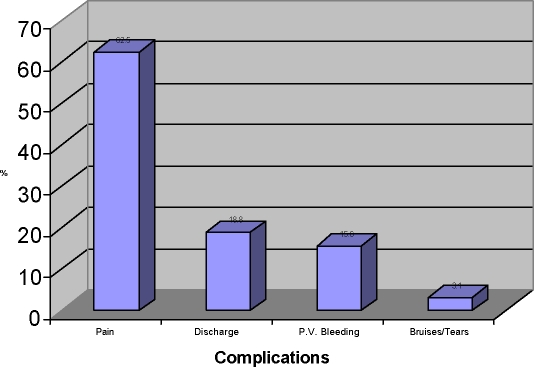Abstract
Objectives
To establish the sexual practices and their associated morbidity among women within 6 months of childbirth in Kampala Uganda.
Design
Cross-sectional descriptive study.
Setting
The three Mulago hospital child immunization clinics. Participants: Two hundred and seventeen eligible mothers took part in the study from November to December 2001.
Outcome measures
Time to resumption of sexual intercourse after childbirth, reasons for resumption and problems associated with it.
Methods
Partially coded questionnaires
Results
Sexual intercourse was resumed by 66.4% of the women within six months of childbirth. Of these 49.3% did so during the puerperium. The main reasons for early resumption of sexual intercourse were husbands' demands, cultural demands and inherent inability to do without sexual intercourse but not level of education of mothers. Of the mothers who resumed sexual intercourse 22.2% had sexual problems. The problems included vaginal pain (62.5%), discharge (18.8%), bleeding (15.6%) and bruises or tears (3.1%). Perineal or genital damage at the time of delivery was not associated with a delayed resumption of sexual intercourse with (OR1.08, 95% CI 0.51–2.30). Of those who had sexual intercourse and had problems only 59.4% sought medical assistance. The reasons for not resuming sexual intercourse within six months of delivery included advise from health workers (38.4%), husbands were away (21.9%), no interest (21.9%) and not feeling well(17.8%).
Conclusion
Most women resumed sexual intercourse within six months of childbirth and had high morbidity. There is need for appropriate postpartum sexual practice advice.
Site of study
Mulago hospital.
Introduction
The postpartum period receives very little attention and care compared to pregnancy and labour in spite of the fact that the majority of maternal deaths and disabilities occur during this period. The attention usually shifts to the newborn baby and the mother gets little care both at home and at a health facility 1.
In a recent survey of postnatal care in Aberdeen Maternity hospital in the United Kingdom, up to 87% of women experienced at least one health problem after delivery2. Barret et al found that in the first three months after delivery up to 83% of the mothers experienced sexual problems. These included dyspareunia, lack of vaginal lubrication, difficulty in achieving orgasm, vaginal loosening, loss of sexual desire and bleeding or irritation after sexual intercourse.3 Similarly, Basson et al found sexual problems such as arousal, orgasm and sexual pain disorders to be highly prevalent especially after delivery.4
Health professionals assume that women will resume normal sexual function after delivery and therefore do not bother to give sexual practice advice. Instead emphasis is put on contraception-related advice. The explanation may lie in the fact that at the six-week checks approximately 60% of women will not have resumed sexual intercourse. Thus the six-week check may be too early to discover chronic problems. 3
In some traditional societies such as the Yoruba in Nigeria, and in some parts of Uganda, women and their husbands are obliged to observe a long time of sexual abstinence after childbirth. One of the main beliefs behind this is that “the man's semen would find its way into the breast of the mother and contaminate the milk that the child is suckling and hence harm its health”. In some societies like among the Yoruba in Nigeria abstinence can be as long as 33 months. This practice has forced women to have long birth intervals and hence reduced fertility levels. On the other hand the amongst the Banyankole society in Uganda, spouses are culturally obliged to resume sexual intercourse shortly after delivery to cerebrate the arrival of the new baby5. This can be as short as 4 days. The implication of this custom on fertility is remarkable. It means that these women have a higher chance of becoming than those who abstain. This would result in high levels of fertility. The women believe that this practice helps in “healing” of the perenial tears and the uterus, as it is believed that the semen has some chemical elements with healing properties. Some men also claim that they resume sexual intercourse to congratulate the wife on producing the child. 5
Several studies have explored sexual function after hysterectomy, 6,7 but few studies have looked at sexual intercourse after childbirth. Childbirth brings about a change in sexual relationship such as perineal pain, dyspareunia, decrease in the frequency of sexual intercourse and women's sexual desire.1,3 Hormonal effects associated with breast-feeding appear to be associated with vaginal dryness and loss of libido, although this finding is not consistent. 8
There is a positive association between levels of dyspareunia and perineal damage (in particular, episiotomy).2,3,9 It is interesting to note that some women prefer elective caesarian section to vaginal delivery since they believe that they will have a smaller chance of dyspaerunia. Obviously this is relevant to is relevant to the debate about the mode of delivery. 2,3 Despite the studies made in popularizing reproductive health and the rights of women in Uganda, there is very little information regarding resumption of sexual practices after child birth.
Therefore the general objective of this study was to establish the time taken to resume sexual intercourse, the sexual morbidity associated with resumption and the prevalence of sexual problems encountered by postpartum women attending immunization clinics in Mulago Hospital in Uganda.
Materials and Methods
Design
The study was a cross sectional descriptive study
Participants
Women who had brought their babies for vaccination in Mulago Hospital immunization clinics.
Setting
Mulago Hospital Child immunization clinics.
Sample size calculation
The sample of 216 was estimated using a formula by Kish and Leisie15. We assumed the expected prevalence of sexual dysfunction to be 83% as found in the UK Study3 with a of precision mean 5% at 95% confidence.
Inclusion criteria
Women who were 3–6 months postpartum.
Women who gave informed consented to join the study.
Sampling procedure and data collection
All the women who had brought their babies for immunization and met the inclusion criteria were recruited. Eligible mothers were consecutively recruited until the sample size of 216 was achieved. One of us (E.O) interviewed the respondents using partially coded questionnaires with both closed and open-ended questions.
Variables
Sociodemographic characteristics, time to resumption of sexual intercourse, problems encountered and the health seeking behaviour, were recorded.
The data collected was coded and fed into a computer using EPI INFO 6.4 statistical package, cleaned and analyzed with assistance of a statistician. Tests of significance were done using the chi squared test and presented using odds ratio with 95% confidence interval.
Ethical considerations
Permission was obtained from the Makerere University Faculty of Medicine research committee, the Mulago Hospital research committee and the National Council of Science and Technology. Informed consent was obtained from the mothers before interviews were conducted. Use of numbers ensured confidentiality and no names appeared anywhere on the questionnaires.
Results
Socio demographic characteristics of the mothers
The majority of the mothers(62.5%) were in the age group 20–29 years.The youngest mother was 17 years while the oldest was 45 years with the mean age of 25 years (SD= 6.02). The minimum age of 17 years corresponded to the early age at first pregnancy and childbirth in our society.
The majority of mothers were Baganda (48.0%) and the rest of the tribes in Uganda were represented as shown in figure 1.
Figure 1.
The tribe of the mothers
The literacy rate of the mothers was high(94.9%) which compares with that of Kampala of 88.4%(Uganda National population census 1991) Most respondents were married(76.5%), the rest were single (13.8%),cohabiting or divorced(5.7%).
Reproductive characteristics of women following delivery
Of those who resumed menstrual periods the earliest time reported for return of menstruation was 2 weeks and the latest time was 24 weeks with mean time of resumption of 9.79 weeks. By 6 weeks 39% of women had resumed menstrual periods.
Most mothers delivered vaginally (80.6%) and 39.4% had an episiotomy done or vaginal laceration. Most episiotomies(87.2%) healed well, though 12.8% became infected.
Sexual practices among women in the postpartum period
One hundred and forty four of the women(66.4%) had resumed sexual intercourse. Half of these(49.3%) had done so during the puerperium. The earliest time was within the first week and the latest time was in the 24th week with mean time for resumption of 7.87 + 4.9 weeks.
Of the women who resumed sexual intercourse within the pueperium 8.5% had done so within the first week.
The advice to mothers by the health workers on discharge after childbirth varied, some workers advised mothers to resume sexual intercourse within 6 weeks while others said after six weeks..
The reasons that were given for the resumption of sexual intercourse are shown in figure 2. These included husbands' demands, advise from health workers, others felt it was just convenient as long as they were feeling well even in the puerperium or to fulfil cultural demands.
Figure 2.
Reasons for resuming sexual intercourse, among women within six months of child birth, Mulago Hospital November – December 2001
The reasons that were given for not resuming sexual intercourse are shown in figure 3. Twenty six mothers had not resumed sexual intercourse because they were not told when it was safe to resume sexual relations.
Figure 3.
Reasons for not resuming sexual intercourse among women within six months of child birth, Mulago Hospital November – December 2001
Thirty-two women (22.2%) experienced significant levels of morbidity and these were vaginal bleeding, dyspaerunia, tears or bruises and vaginal discharge. These are shown in figure 4.
Figure 4.
Nature of problems after resumption of sexual Intercourse among women within six months of childbirth Mulago Hospital, November – December 2001
Factors associated with resumption of sex among the mothers within the puerperium
Some mothers resumed sexual intercourse because they were fulfilling cultural demands, but this was not significant. Though the number of respondents were few, the mothers from western Uganda (Banyankole, Bakiga, Batoro, etc) were more likely to resume sexual intercourse within the early days of puerperium. The education level of the mothers perineal or genital damage at the time of delivery, and the mode of delivery were associated with early resumption of before 6 weeks. This is shown in table 1.
Table 1.
Factors associated with resumption of sexual intercourse among women within six weeks of childbirth in Mulago Hospital November – December 2001
| Factor | Resumed | Odds | 95% | P-Value | |
| Yes | No | Ratio | Confidence Interval |
||
| Cultural Reason | |||||
| Yes | 50 | 94 | 1.15 | 0.76 – 1.74 | 0.498 |
| No | 22 | 51 | |||
| Tribe | |||||
| Western Uganda | 41 | 87 | 0.84 | 0.53 – 1.33 | 0.471 |
| Other | 16 | 26 | |||
| Educational Level | |||||
| Up to primary level | 34 | 46 | 1.53 | 1.06 – 2.22 | 0.026 |
| Above primary level | 38 | 99 | |||
| Marital Status | |||||
| Married | 60 | 116 | 1.16 | 0.69 – 1.92 | 0.55 |
| Not married | 12 | 29 | |||
| Mode of delivery | |||||
| Vaginal | 68 | 109 | 3.84 | 1.49 – 9.92 | 0.0005 |
| Caeserian Section | 4 | 36 | |||
| State of Perineum | |||||
| Intact | 55 | 82 | 1.73 | 1.08 – 2.79 | 0.0159 |
| Perineal Damage | 16 | 53 | |||
Health seeking behaviour of women when having problems after resumption of sex
Of the 32 women with problems only 19 sought for help. The mean age of mothers who sought help was 28.0 years, and those who did not seek help was 21.0 years. The difference in the age was statistically significant; (P=0.016486). The other factors viz. tribe, education level, marital status and parity against the health seeking behaviour are shown in table2.
Table 2.
Health seeking behaviour of the mothers
| Factor | Sought Help | Odds Ratio | 95% | P-Value | |
| Yes | No |
Confidence Interval |
|||
| Tribe | |||||
| Ganda | 9 (47.4%) | 5 (38.5%) | 1.16 | 0.66 – 2.04 | 0.623 |
| Other | 10 (52.6%) | 8 (61.5%) | |||
| Educational Status | |||||
| Up to primary level | 8 (42.1%) | 2 (15.4%) | 1.6 | 0.95 – 2.69 | 0.115 |
| Above primary level | 11 (57.9%) | 11 984.6%) | |||
| Marital Status | |||||
| Married | 17 (89.5%) | 13 (100%) | 0.57 | 0.41 – 0.77 | 0.234 |
| Single | 2 (10.5%) | 0 | |||
| Parity | |||||
| Primigraride | 7 (36.8%) | 7 (53.8%) | 0.75 | 0.4 – 1.39 | 0.348 |
| Others | 12 (63.2%) | 6 (46.2%) | |||
Mean age of those who sought treatment 29 years (SD + 7.44) range 20 – 45 yrs
Mean age of those who did not seek treatment 23(SD6.71) range 17 – 42 yrs
T- test t = 2.540, p = 0.0156.
Discussion
Sexual health of women is not well addressed since sexual issues are considered to be private issues. Sexual morbidity increases significantly after childbirth. When sexual questions are asked routinely in medical practice rather than waiting for the patient to broach the subject, twice as many problems are reported.10
In this study half of the mothers (49.3%) who resumed sex did so during the pueperium. The mean time for resumption of sexual intercourse was 7.87± 4.9 weeks. This is shorter than the one reported in Nigeria of 16.5 weeks.11 The difference could be accounted for by cultural difference although in this study culture was found not to affect resumption of sexual activity.
Women cited many reasons as to why they resumed sexual intercourse early and especially in puerperium. The demand by husbands was an important factor because 46% of mothers who resumed early reported that their husbands demanded to have sex. Similarly, culture is an important factor since 10.0% of women who resumed sexual relations did so because they were fulfilling cultural demands. For instance, in some cultures it was stated that a woman was expected to resume sexual intercourse within the first week after delivery “so as to help in the healing of the wounds” and “to bring good health to the baby”. Burton et al also reported this in their survey on Ankole women.5 Other women resumed sexual intercourse early because “they were entering a new house” or some mothers thought that “as long as they were feeling well” they were justified to resume sexual intercourse even in the pueperium.
In our study, 22.2% of mothers reported a high morbidity. This was similar to that reported by Brown and Lumley 10 of 26.3% among Australian women and Walraven et al12 among Gambian women reported 27%. However, Barrett et al reported a higher figure of 83% at the first 3 months declining to 64% at 6 months of childbirth.13
Their figure was higher because they included other qualities of sexual responses like the desire, arousal and the problems associated with orgasm following childbirth. These problems included vaginal bleeding and discharge, bruises or tears, and dyspaerunia. These have been reported in other studies as well.3,10, 11 Other than causing physical injuries to the mothers such as bruises, bleeding and pain when sexual intercourse is resumed during pueperium, chances of transmission of diseases including HIV are high when healing of the genital mucosa is incomplete. Half of the mothers with sexual problems sought assistance but they felt shy to talk about these problems. The majnority went to less qualified personnel for advice and treatment. The rest were too shy to seek treatment and either administered their own treatment or they said the problem was over on the same day.
Conclusion
Most women resumed sexual intercourse within six months of delivery and had high morbidity. This indicates that there is need to develop educational programmes on sexual practices after child birth and pass the information to women and their spouses.
Acknowledgement
We would like to thank Mr. Gideon Kikampikaho, the Deputy Director of Mulago hospital for giving us permission to publish the work. We acknowledge with thanks, Prof. Mirembe for the support and advice while conducting this study. Lastly but not least the in-charge of the Immunisation Clinics and Maureen Ssekisolo for the secretarial work.
References
- 1.Shokrollahi P. Prevalence of sexual dysfunction in women seeking services at family planning central in Uganda safe Motherhood LSS, Module 4, Revised. 1999. Mar, [DOI] [PubMed] [Google Scholar]
- 2.Carroli G. The cochrane library. 3. Oxford: Up date software; 1998. Episiotomy policies in vaginal births. [Google Scholar]
- 3.Barret G. Women's sexual health after childbirth. Br J Obstet Gynaecol. 2000;107(2):186–195. doi: 10.1111/j.1471-0528.2000.tb11689.x. [DOI] [PubMed] [Google Scholar]
- 4.Basson R, et al. Report of international consensus development conference on female sexual dysfunction: definitions and classifications. J-Urol. 2000;163(3):888–893. (Medline Review). [PubMed] [Google Scholar]
- 5.Burton K, et al. Sexual obligations and Taboos in some Aspects of determinants of fertility in Ankole, Uganda. Findings of elder survey. 1990 [Google Scholar]
- 6.Kalisoke, author. MMED. 1983. Sexual function after hysterectomy; pp. 424–444. Dissertation (Gynecological long commentary) of Makerere University. [Google Scholar]
- 7.Popov IS. Disorders in sexual function following hysterectomy. Akush Ginekol Sofila. 1998;37(3):38–41. (Medline review) [PubMed] [Google Scholar]
- 8.Burnap DW. Sexual problems in medical practice. Journal of medical education. 1967;42:673–680. doi: 10.1097/00001888-196707000-00006. [DOI] [PubMed] [Google Scholar]
- 9.Kettle C. The cohrane library. 3. Oxford: Up date software; 1998. Continuous versus interrupted sutures for perineal repair. [DOI] [PubMed] [Google Scholar]
- 10.Brown S. Maternal health after childbirth: Results of an Australian population based survey. Br J Obstet Gynaecol. 1998;105:156–161. doi: 10.1111/j.1471-0528.1998.tb10045.x. [DOI] [PubMed] [Google Scholar]
- 11.Adinma JI. Sexual activity during and after pregnancy. Adv Contracept. 1996;12(1):53–61. doi: 10.1007/BF01849546. [DOI] [PubMed] [Google Scholar]
- 12.Walraven G, et al. The burden of reproductive diseases in rural women in The Gambia, West Africa. The Lancet. 2001;357:1161–1167. doi: 10.1016/S0140-6736(00)04333-6. [DOI] [PubMed] [Google Scholar]
- 13.Barret G. Sexual function after childbirth: Women experiences, persistent morbidity and lack of professional recognition. Br J Obstat Gynaecol. 2001;105(2):242–244. doi: 10.1111/j.1471-0528.1998.tb10066.x. [DOI] [PubMed] [Google Scholar]
- 14.Glazener CM, et al. Postnatal maternal morbidity: Extent, causes, prevention and tretment. Br J Obstet Gynaecol. 1995;102:282–287. doi: 10.1111/j.1471-0528.1995.tb09132.x. [DOI] [PubMed] [Google Scholar]






